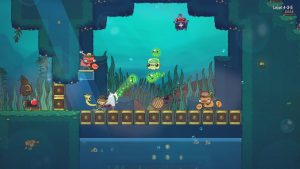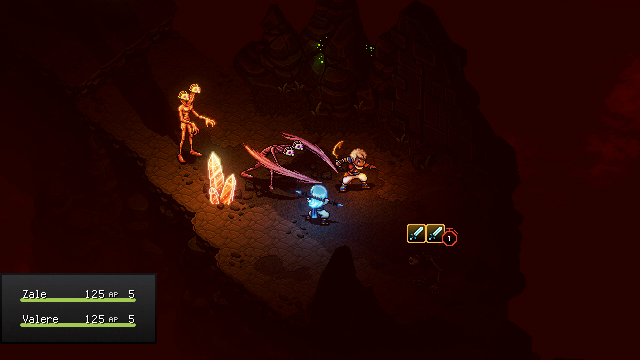*Sabotage Studios’ upcoming retro-inspired game “Sea of Stars” reached more than 10 times its original funding goal of $93,711—hitting $1.1 million, as of May 1—less than a month after launching a Kickstarter campaign.
That’s just one example of the exploding trend of indie developers making retro-style games to feed a growing gamer audience hungry for classic role-playing games, or RPGs.

Thierry Boulanger, the creative mastermind behind “Sea of Stars,” cites “Super Mario Bros.” and the beloved 1995 classic RPG “Chrono Trigger” as major inspirations.
“It dates back to growing up in the ’90s; there were a bunch of games that left a permanent mark and defined gaming,” Boulanger told Zenger News. “For me, it was always this drive to make these games to pay homage to those experiences that I feel sadly got lost as production value got bigger. Through harsher limitations there was a very unique, more-to-the-point experience that emerged. The same with the music; you have to have the hook right away because there are short loops” in old games.
When Boulanger found out that Yasunori Mitsuda, the critically acclaimed composer for “Chrono Trigger,” would contribute music to his new game, he cried.
“’Chrono Trigger,’ for many of us, aged back to riding your bicycle,” said Boulanger. “It kind of comes full circle. The reason you set out to make games for a living is for that approval. Every time there was a business trip, we would always try and ask him—and all we ever got was how big of a long shot it was. Surprisingly in the end, we ended up not having a contact or a direct connection, we just sent an email to his studio, and the person who handles English communications wrote back and said, ‘OK, well, we can always take a look at your project,’ and for some reason, it resonated, and he felt compelled to contribute music when he saw it. I don’t want to get emotional, but that was a big validation to be getting. We managed to trigger that reaction within him, so it means the world.”
Boulanger’s “Sea of Stars” is a traditional RPG about a group of adventurers solving mysteries, and serves as a prequel to Sabotage Studio’s first game, the retro-style platformer, “The Messenger.”
“Without knowing exactly why, ‘I want to write music for this game’ was the feeling I had while seeing it convey the nostalgic golden age of the ’90s,” Mitsuda said in a statement about his decision to contribute music to “Sea of Stars.”
Boulanger’s game is part of a strong trend within the indie developer community to make retro-style games that not only pay homage to the classics but forge new territory in the industry.
While big budget developers such as AAA, Bethesda, Epic Games, Infinity Ward, Kojima Productions and Rockstar Games focus on creating games with huge budgets, elaborate marketing schemes, sprawling worlds, the latest and very best graphics and often rely on multiplayer online modes, like “Fortnite,” indie developers with limited budgets are getting back to the basics with classic storytelling, inspiring music and retro aesthetics that are now considered video game art.
Justin Stander, who created the hugely popular 2019 retro-style RPG “Katana ZERO,” which sold 100,000 units for Nintendo Switch during the first week of its release—an impressive feat for a previously unknown indie developer—and was nominated for Best Independent Game at the 2019 Game Awards, enjoys the look of vintage games and wanted to replicate it for his own.
“I love the look of pixel art and visually striking lighting effects, so the neo-retro pixel aesthetic was a perfect match for ‘Katana ZERO,’” Stander told Zenger News in an email. “I’ve also always preferred making games with a fixed 2D perspective, since it allows me to tailor the visual information that the player sees to create a more streamlined experience. Surprisingly, I don’t play a lot of games, and I’ve played even less retro platformers—but I’ve always liked the cinematic levels and set pieces of ‘Another World.’”
According to a variety of sources within the video game industry, the reason indie developers are making so many retro-style games comes down to two main factors: budget and nostalgia.
“When indie games started in the mid-2000s, there weren’t a bunch of freely available game engines,” said Sam Roberts, director of IndieCade, the annual international indie games festival. “Just doing the work was time-consuming. Even if you could build your own 3D assets, just the sheer amount of time to compete to look as good as an AAA game at the time period, there was no way. So a lot of early indie developers switched to 2D graphics and 16-bit graphics just because of the scale of development of what was available to them. In the mid-2000s, you could not have a high-quality, photo-realistic game, so you had to have an aesthetic. And if you had a really good aesthetic, you could make it really beautiful. This was basically born out of need and necessity.”
The developers making indie games in the mid-2000s grew up playing games on the Super Nintendo Entertainment System Classic, and wanted to create games in the style of the old games they loved.
“So in addition to an economic factor, that was how they’d grown up thinking about games, they had passion and love for those games, and were interested in exploring those spaces,” Roberts told Zenger News. “One of the things that helped indie games get big was this retro game aesthetic and the big developers’ single-minded pursuit of high-res, photo-realistic graphics and moving almost exclusively towards first person meant that game genres that had been popular in the ’80s and ’90s were falling away. If you loved ‘Super Mario Bros.’ in a 2D style, Nintendo stopped making those for a while. People weren’t really making them in AAA studios. If you loved 16-bit era RPGs, you couldn’t get them from big studios.”
After that first indie retro-style game boom, there’s now a resurgence drawing inspiration not only from the ’80s and ’90s games but also from the mid-2000s retro-style games. That, in turn, has drawn the big names.
“So now Dragon Quest 11, which has been around since it was an 8-bit RPG on the Nintendo, is now produced with beautiful 3D graphics and you can choose to play it in a 16-bit style,” Roberts said. “They literally made a whole 16-bit style to play the game in, because they’re losing audience to competitors in that style.”
The video game market is almost over-saturated with video games to choose from on PCs and consoles, so indie developers—many of which are startups and entrepreneurs with very small budgets—often use Kickstarter campaigns to get the funding they need to make a game.

Anya Combs, director of games outreach at Kickstarter, said the indie developer trend toward vintage games largely comes down to expenses, because retro-style games made with old-school aesthetics and techniques are much cheaper to make than big-budget ones like Kojima Productions’ 2019 game “Death Stranding,” which won multiple gaming awards for its design and reached 3 million users in April 2020.
“It really just comes down to budget,” she told Zenger News. “When you talk about games that are $20 million, funding something like that on Kickstarter is difficult. The video game budgets on Kickstarter are usually $50,000-$150,000. We do see some of the more retro action-adventure games come to Kickstarter. They’re not easy, necessarily, but there’s less complexity that goes into some of the retro games.”
For many indie developers, creating a fan base and community that supports the game is critical to actually finishing the game and then selling it and recouping expenses. Without Kickstarter, many indie games get lost in the shuffle and never pick up traction among gamers. Without a community cheering them on, indie developers lose money.
“Having a community associated with it helps through the funding process,” Combs said. “It’s kind of twofold, from a data standpoint, what we see is a 30-70 percent split. Thirty percent of the pledges to the project are essentially from Kickstarter, from people searching for the game, finding the game. That means 65-75 percent of the pledges need to come in from the community the creator needs to build. The community is absolutely key to bringing those pledges in.”
Combs said creating that community can help indie developers continue to be successful after their first game, especially if pledges end up loving the game.
“The upside to the Kickstarter project is, you have people who are going to follow you throughout your entire career,” she said. “They’ve been through that development process since day one, so the more you launch projects, the more likely they are to follow you.”
Tapping into gamers’ nostalgia is also key to a successful retro-style indie game — for the developers and also the audience.
“People are so inspired by the content they consume, so it kind of makes sense that, ‘Oh, I played ‘Mario’ growing up so I want to create something that’s similar,’” Combs said. “One of the cool things I also see a lot of is taking that traditional genre and adding other elements to it that are different and interesting. ‘WonderZone,’ for example, uses music to enhance the game play. ‘The Adventure Pals’ was a game that was funded in 2016 or 2017, [and they] take those traditional platformer elements, but instead of running around, you’re riding a giraffe, which is kind of cute and weird and adorable.”
Stander did something similar to “The Adventure Pals” with “Katana ZERO,” by tweaking the classic RPG genre with unique details: His game features an assassin who uses a bathrobe to dress as a samurai and runs around with a katana in a dystopic, ‘Blade Runner’-esque world with ’90s motifs like VHS tapes.
“A lot of the themes in ‘Katana ZERO’ are inspired by my favorite films,” Stander told Zenger News in an email. “The bleak dystopian imagery is distilled from Korean revenge thrillers like ‘Oldboy’ and ‘The Man from Nowhere,’ as well as art house movies like ‘Drive’ and ‘Sin City.’ The obsessive and mysterious characters in my game are influenced by films like ‘Taxi Driver,’ ‘A History of Violence,’ and several of Werner Herzog’s films. The samurai movie references are mainly used as a contrast to the bloodlust of the main character. He dresses as a samurai and uses a katana because he wants to emulate his heroes from the movies. After all, if those samurai can live a life revolving around violence and kill people with a sense of honor, then why can’t he?”

Stander, who programmed the entire game by himself, called the work a “monumental task” — especially when you need a dedicated audience to make the game successful.
Jay Armstrong, one of the developers for “The Adventure Pals,” said Kickstarter and community-building was essential to the game’s success.
“The audience is absolutely central to everything,” he said. “We toured ‘The Adventure Pals’ mercilessly! We went to hundreds of shows all across the world. It was great promotion for the game, but the main thing was to watch people play. Any time someone snagged themselves on a corner, or went the wrong way, or didn’t understand something, or it took them half a second longer to see something then they should have done, we made a note and fixed it. The game we have now started out so differently before we had people play it.”
Armstrong also said that he and his team wanted the game to represent their personalities, and a retro-style platform game was the best way to do that.
“We’ve always loved platformer games,” he told Zenger News in an email. “It is such a wonderful genre—it allows you to create anything, with so much freedom in the way you express your game, from the way your character moves to the depth of your combat, to the way you tell your story. We really wanted to use a platformer to create a feeling of freedom and joy, as you bounce off enemies, whack them with your sword and grapple away using your giraffe’s super-stretchy neck! We also wanted to add really light RPG elements, and the feeling of a big world, so we took inspiration from ‘Zelda 2,’ which has a big top-down world map you can move freely around in, but the action takes place as a 2D side scroller.”

Even though Sabotage Studio’s “Sea of Stars” is fully funded on Kickstarter, the game is still two to three years away from completion, according to Boulanger. Gamers will wait for a good game, no matter how long it takes, especially if indie developers get a fan base.
Despite the long hours and hard work, sometimes with little guarantee of success, indie developers make retro-style games first and foremost because they love them—and audiences pick up on that.
“Creating ‘The Adventure Pals’ was one of the longest and hardest journeys I have ever been on,” Armstrong said. “It’s exhausting, it’s tough, it’s scary, it’s financially reckless and there is no guarantee that any of it will work out in the end. But you know what? The sheer joy of waking up every day and being able to create something that you believe in, that allows you to express your creativity fully and that you (hope) will bring a little more joy into this world is worth all of those things and more.”
Editing by Matthew Hall and Allison Elyse Gualtieri
The post Back to Basics: Why indie developers are leading a retro-style video game resurgence appeared first on Zenger News.
We Publish News 24/7. Don’t Miss A Story. Click HERE to SUBSCRIBE to Our Newsletter Now!






